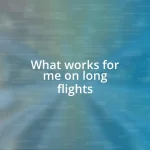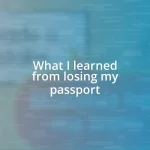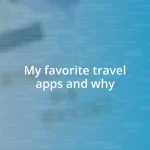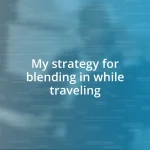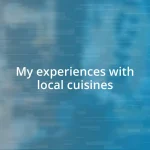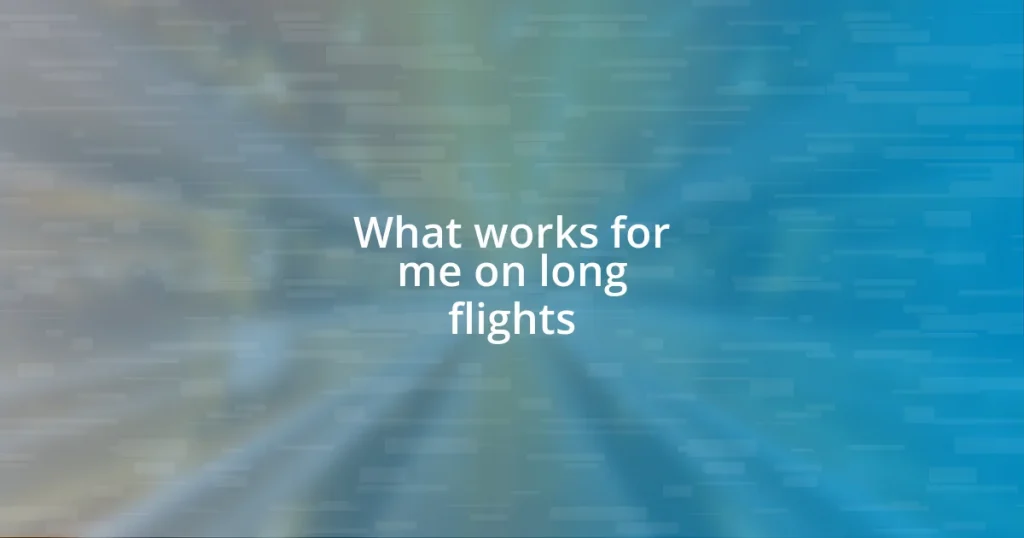Key takeaways:
- Understanding personal travel goals enhances the overall experience, leading to more meaningful interactions with the culture.
- Researching city layouts, using various navigation tools, and leveraging local transport can greatly improve confidence and ease when exploring new places.
- Connecting with locals and utilizing community resources enriches travel experiences, providing unique insights and authentic cultural engagements.

Understanding your travel goals
Understanding what you want from your travel experience is vital. Are you chasing adventure, cultural immersion, or relaxing getaway? I remember my first trip to Barcelona; I thought I wanted to see all the famous sights, but what truly moved me was wandering down less-traveled streets, soaking in local life.
Setting clear travel goals helps focus your energy and resources. For instance, during a recent trip to Tokyo, I initially wanted to check off every tourist spot. But when a friend suggested attending a traditional tea ceremony, everything shifted for me. That experience was not only unforgettable; it perfectly aligned with my desire to explore authentic culture.
Reflecting on what excites you and fuels your curiosity can shape your journey significantly. Do you cherish culinary delights or perhaps connecting with locals? When I tailored my Paris itinerary around food markets and cooking classes, I discovered a deeper connection to the city that I never anticipated. It was a game-changer for me!
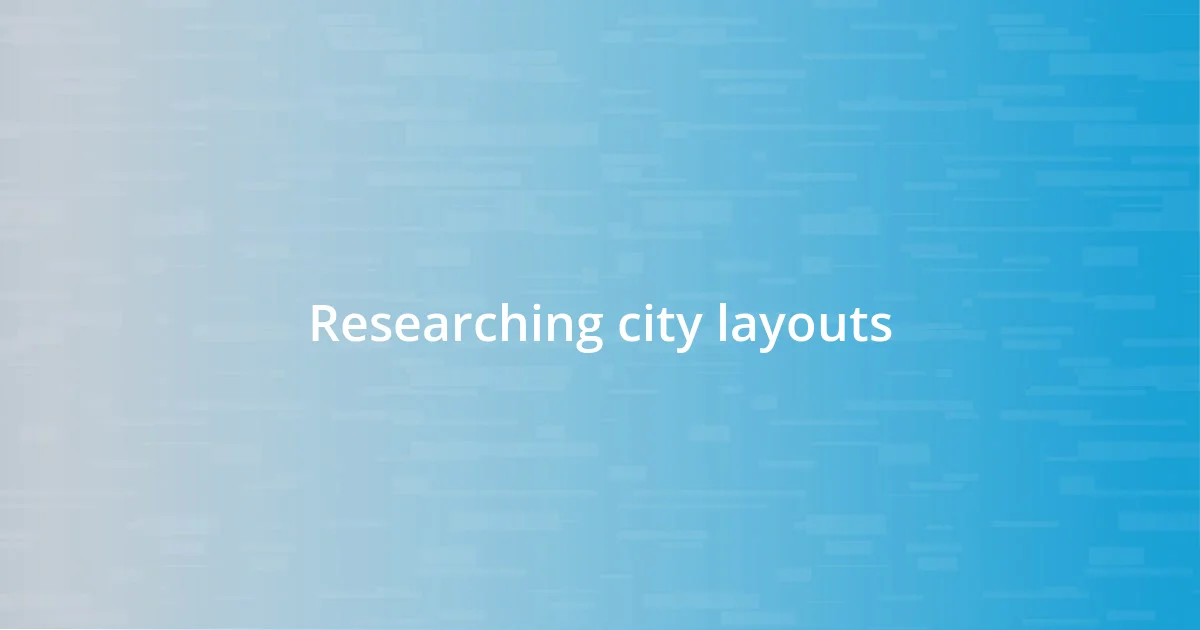
Researching city layouts
When I dive into exploring new cities, one of my first strategies is researching the city layout. Understanding how a city is structured can make all the difference in how I navigate it. For instance, when I first visited Amsterdam, I was fascinated by its concentric ring pattern. Knowing that I could simply cross bridges to reach connected areas helped me feel more at ease and confident.
Here are some key elements I consider when researching city layouts:
- Street Maps: I always grab a detailed map and highlight the places I want to visit. It provides a visual perspective that a digital map sometimes can’t convey.
- Public Transport: Understanding the transit routes and stops ahead of time saves me valuable time and prevents stress.
- Neighborhoods: I love reading about different districts. Each captures its own unique vibe, which can enhance my travel experience significantly.
- Walking Paths: Exploring pedestrian-friendly routes can reveal hidden gems that aren’t visible from the main roads.
- Local Resources: I search for local blogs or guides that discuss nuances of the city. It often leads me to spots that aren’t in mainstream travel books.
By integrating these elements into my research, I create a mental map that complements my physical exploration, making each city feel more like a friend than a stranger.
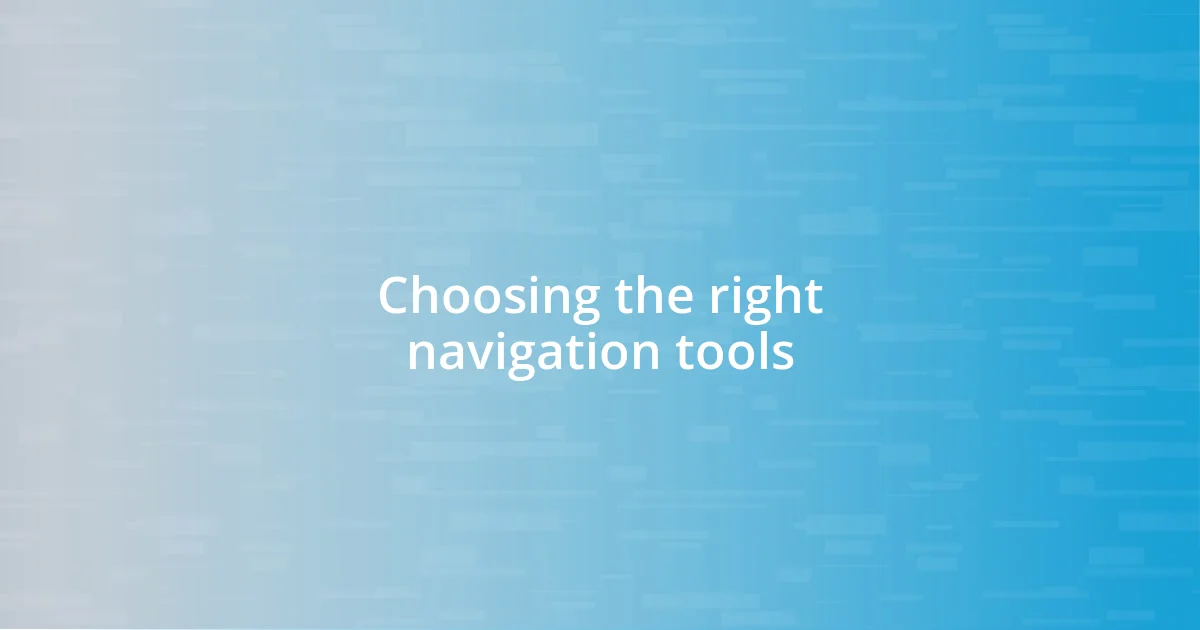
Choosing the right navigation tools
Choosing the right navigation tools is an essential part of my travel experience. I’ve learned that having the right resources at hand can really make or break my adventures. For instance, while navigating the narrow streets of Florence, I relied on a combination of a reliable GPS app and offline maps. This combination allowed me to explore with confidence, even when my phone lost signal in the more rustic parts of the city.
I also discovered that traditional tools, like physical maps, can be incredibly valuable. During a trip to Lisbon, I picked up a detailed tourist map that highlighted local attractions and lesser-known cafes. I found myself completely absorbed in the city’s vibes, taking unexpected turns that led me to charming squares and quaint pastry shops. There’s something special about unfolding a map and visually plotting my next stop that adds to the excitement.
Ultimately, it’s about finding what resonates with your style of exploring. I recommend trying different navigation methods until something clicks. For example, using a walking tour app during a stroll in Madrid provided me with insights I would have missed otherwise. The historical context coupled with real-time directions deepened my appreciation for the city. By combining technology with tactile tools, I feel more empowered to step off the beaten path and truly experience my surroundings.
| Tool | Advantages |
|---|---|
| GPS Apps | Real-time directions, quick updates on traffic, and ability to search for nearby attractions. |
| Offline Maps | Reliable when cell service is spotty, and can provide a sense of orientation in unfamiliar areas. |
| Physical Maps | Visual representation allows for spontaneous exploration and a tactile connection to the city. |
| Walking Tour Apps | Contextual information about historical sites, enhancing the overall experience while navigating. |

Utilizing local transportation options
Utilizing local transportation options can be a game changer in my city explorations. I vividly recall hopping onto the tram in Budapest, feeling that rush of excitement as I glided past stunning architecture. Trams, buses, or trains can take you to areas you might not have discovered on foot. Have you ever noticed how local transport often whispers secrets of a city that you might miss otherwise?
When navigating through a new place, I make it a point to familiarize myself with the local transportation system. I often download transit apps that provide real-time updates and map out connections. During my visit to Tokyo, I was genuinely surprised to see how efficiently the trains operated. By leveraging this efficiency, I was able to visit several neighborhoods in a single day, transforming what could have been a stressful experience into a delightful urban adventure.
I also enjoy chatting with locals about their preferences in transportation. Sometimes, their insights reveal hidden routes or affordable options that aren’t always clearly marked. For instance, while exploring Barcelona, a friendly barista recommended a little-known bus route that led me straight to a stunning viewpoint. Engaging in these conversations not only enriches my travel experience but deepens my connection to the community. How often do we underestimate the power of a simple interaction when navigating unfamiliar streets?
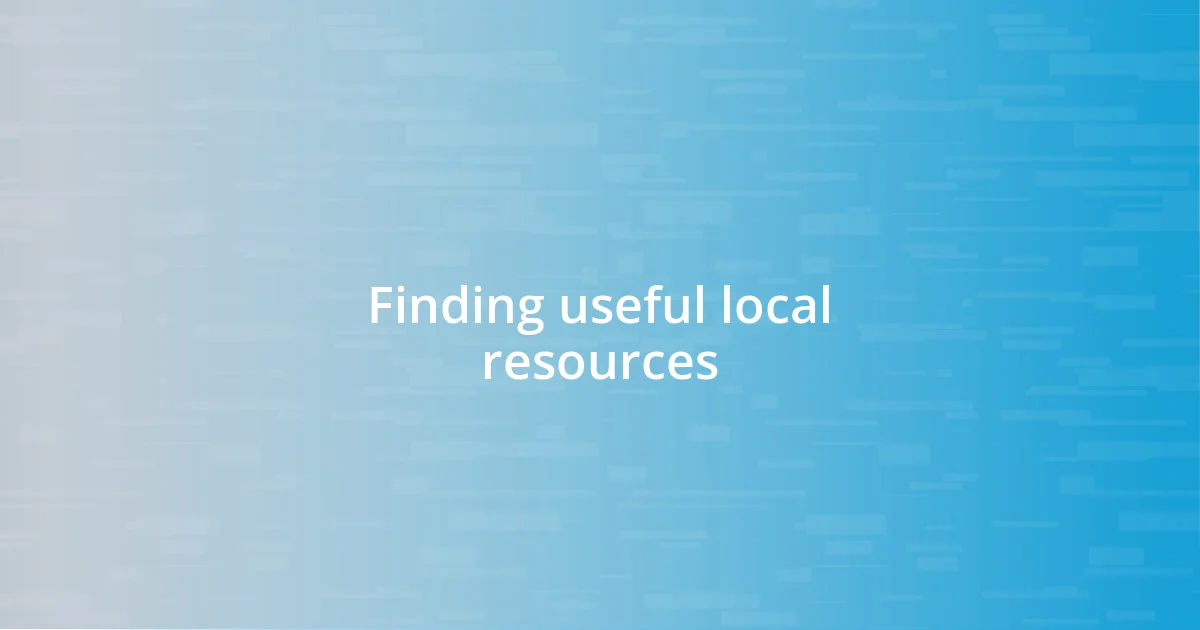
Finding useful local resources
Finding local resources while exploring a new city can truly elevate my experience. I remember my first trip to Buenos Aires; I stumbled upon a local community center that offered walking tours led by residents. It was eye-opening! They provided rich stories that you simply wouldn’t find in any guidebook. Engaging with local resources like these opens up a whole new layer of understanding about the culture and the people.
Another gem is connecting on social media. Before my trip to Athens, I joined a group for travelers. Someone shared the location of a quaint bookshop that doubled as a cozy café, and I couldn’t resist the urge to check it out. Walking into that little haven, I was greeted by the owner, a passionate storyteller who shared the city’s history over a delicious cup of Greek coffee. Have you ever felt that rush of excitement when you find a hidden local treasure? It truly makes the journey feel authentic.
I also love utilizing local apps that recommend resources based on what’s trending in the area. During my last visit to Melbourne, I found an app that directed me to live music venues not listed in traditional guides. Each place had its own vibe, and each night felt like a mini-adventure. It’s remarkable how something as simple as an app can lead to unforgettable experiences, don’t you think? Exploring through these various local resources not only enhances my trip but makes me feel more connected to the city itself.
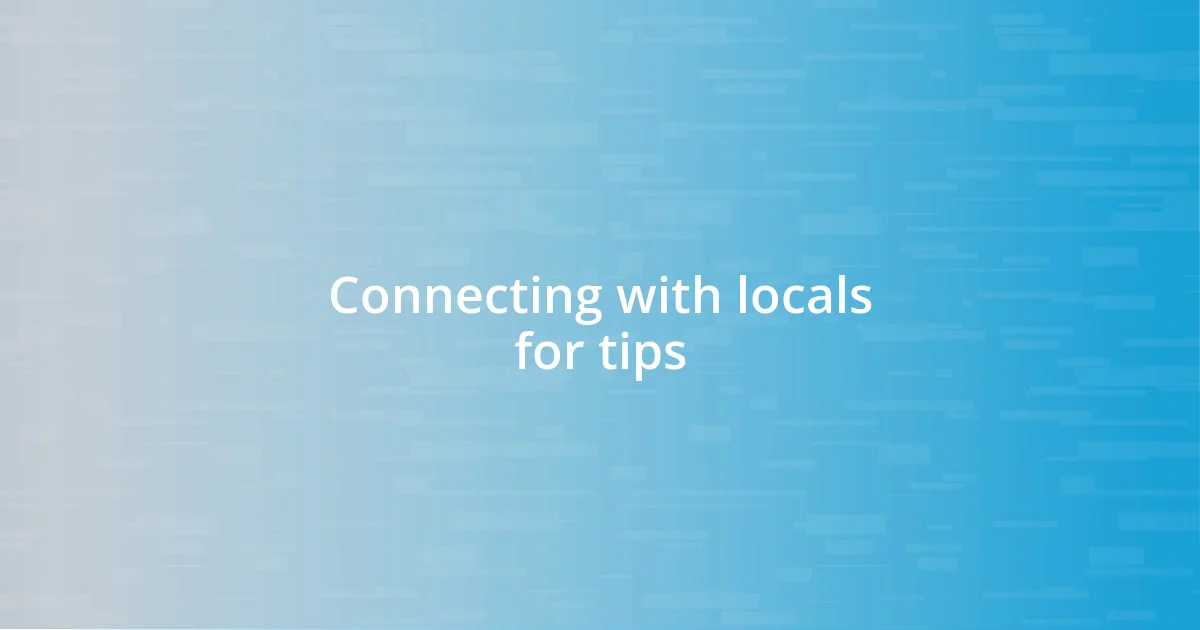
Connecting with locals for tips
Connecting with locals can be one of the most rewarding aspects of traveling. I remember sitting at a community table in a small café in Lisbon, sharing a meal with a group of locals. They not only pointed me to the best azulejos but also shared stories of their city that I never would have known. How often do we overlook the value of these intimate conversations when traveling?
I’ve often found that simply smiling and asking for suggestions can lead to delightful discoveries. For example, during a stroll through a market in Seoul, I struck up a chat with a vendor selling delicious street food. He ended up recommending a hidden gem of a restaurant, where I savored the best bibimbap I’ve ever had. It reminded me that locals know their city like the back of their hand and are often more than willing to share their favorite spots.
Additionally, I like to engage in cultural activities where I can meet locals more organically. In Florence, I took a cooking class where not only did I learn to make fresh pasta, but I also got to know the instructors on a personal level. They shared their family recipes and recommended the lesser-known trattorias that felt like a slice of home. Have you experienced that feeling of warmth when a local opens up their world to you? Those connections can turn an ordinary trip into a rich tapestry of experiences and memories.
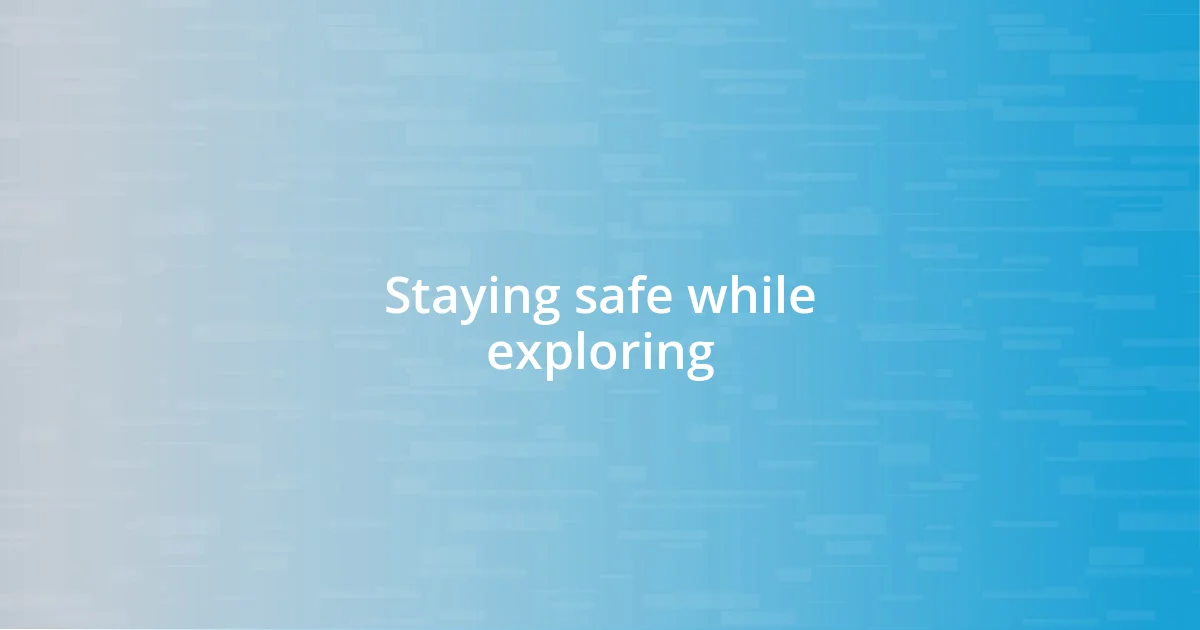
Staying safe while exploring
Staying aware of your surroundings is paramount when exploring a new city. I remember wandering through the bustling streets of Mumbai, feeling both exhilarated and cautious. The vibrant chaos is captivating, but I quickly learned to avoid distractions, like my phone, while walking. Have you ever lost track of where you are simply because you were too focused on your device? It’s a reminder to stay present.
Another important strategy for safety is to trust your instincts. Once, while meandering through the alleys of Tangier, I felt uneasy in a quieter part of town. I didn’t hesitate to pivot and head back toward the busier streets. I’ve found that when something feels off, it’s best to listen to that gut feeling. How often do we let our desire to explore overrule our natural sense of caution?
Lastly, I prioritize blending in rather than standing out as a tourist. During my travels in Barcelona, I chose to dress like the locals, which not only caught less attention but also allowed me to enjoy my surroundings more freely. It’s fascinating how simple choices can significantly impact your experience and safety. What small adjustments could you make to feel more like a part of the city you’re exploring?


